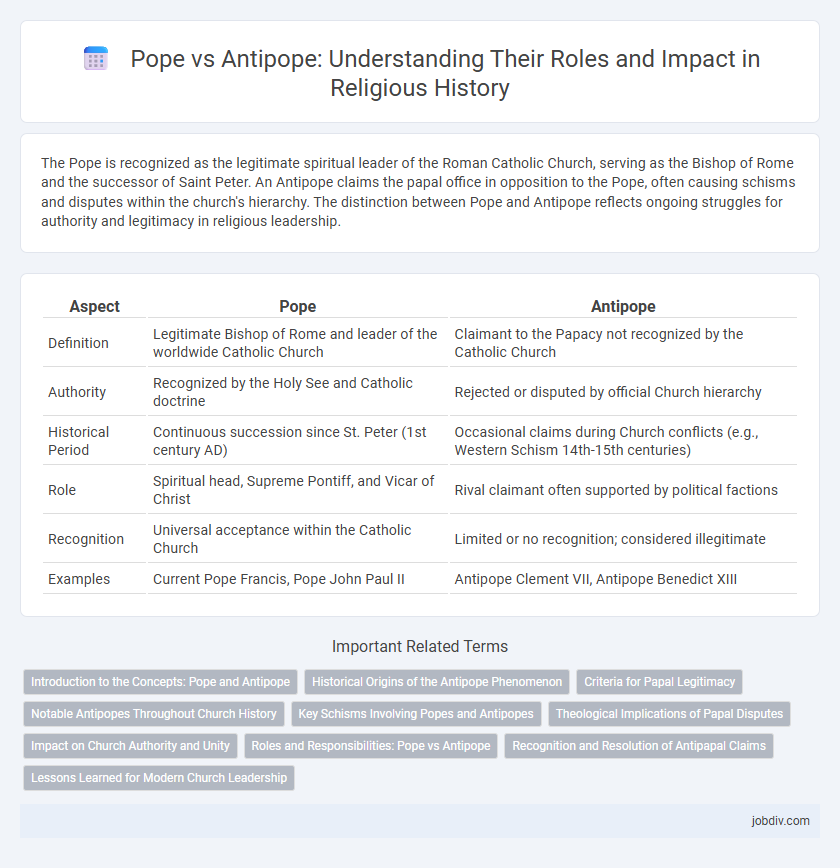The Pope is recognized as the legitimate spiritual leader of the Roman Catholic Church, serving as the Bishop of Rome and the successor of Saint Peter. An Antipope claims the papal office in opposition to the Pope, often causing schisms and disputes within the church's hierarchy. The distinction between Pope and Antipope reflects ongoing struggles for authority and legitimacy in religious leadership.
Table of Comparison
| Aspect | Pope | Antipope |
|---|---|---|
| Definition | Legitimate Bishop of Rome and leader of the worldwide Catholic Church | Claimant to the Papacy not recognized by the Catholic Church |
| Authority | Recognized by the Holy See and Catholic doctrine | Rejected or disputed by official Church hierarchy |
| Historical Period | Continuous succession since St. Peter (1st century AD) | Occasional claims during Church conflicts (e.g., Western Schism 14th-15th centuries) |
| Role | Spiritual head, Supreme Pontiff, and Vicar of Christ | Rival claimant often supported by political factions |
| Recognition | Universal acceptance within the Catholic Church | Limited or no recognition; considered illegitimate |
| Examples | Current Pope Francis, Pope John Paul II | Antipope Clement VII, Antipope Benedict XIII |
Introduction to the Concepts: Pope and Antipope
The Pope is the Bishop of Rome and the supreme leader of the worldwide Catholic Church, recognized as the spiritual successor to Saint Peter. An Antipope is a person who, in opposition to the Pope, claims to be the legitimate pontiff, often during periods of schism or political conflict. The distinction between Pope and Antipope is critical in Church history, reflecting struggles over papal authority and legitimacy.
Historical Origins of the Antipope Phenomenon
The phenomenon of antipopes originated in the early centuries of the Christian Church, particularly during periods of political instability and contested papal elections. Antipopes emerged as rival claimants to the papal throne, often supported by factions opposing the legitimate pope, reflecting broader conflicts between secular and ecclesiastical authorities. These disputes peaked during the Western Schism (1378-1417), when multiple individuals simultaneously claimed the papacy, challenging the unity and authority of the Roman Catholic Church.
Criteria for Papal Legitimacy
Papal legitimacy is primarily established through election by the College of Cardinals in accordance with canon law, apostolic succession, and recognition by the Roman Catholic Church hierarchy. An antipope emerges when a claimant to the papacy lacks valid election or is not universally recognized by the Church, leading to a schism. Key criteria include proper canonical election, acceptance by the faithful, and communion with the broader Church community.
Notable Antipopes Throughout Church History
Notable antipopes in church history include Clement VII, who challenged Pope Urban VI during the Western Schism, and Benedict XIII, whose claim prolonged ecclesiastical division in the 14th century. Antipopes often arose from political conflicts and rival factions within the Catholic Church, leading to significant religious and social turmoil. Their contested legitimacy fundamentally shaped the development of papal authority and church unity in medieval Europe.
Key Schisms Involving Popes and Antipopes
The key schisms involving popes and antipopes center on the Western Schism (1378-1417), where multiple claimants to the papacy, including Urban VI and Clement VII, divided Christendom between Rome and Avignon. This schism was further complicated by the Council of Pisa in 1409, which attempted to resolve the crisis but instead elected another pope, Alexander V, leading to three simultaneous papal claimants. The resolution came with the Council of Constance (1414-1418), which deposed or accepted the resignation of all claimants and elected Pope Martin V, restoring unity to the Catholic Church.
Theological Implications of Papal Disputes
Papal disputes between the Pope and Antipope reveal profound theological implications regarding the nature of apostolic succession and the authority of the Church. These conflicts challenge the doctrine of papal infallibility and the unity of the Magisterium, raising questions about legitimate spiritual leadership. The resulting schisms highlight the tension between divine guidance and human fallibility within ecclesiastical hierarchy.
Impact on Church Authority and Unity
The conflict between a pope and an antipope severely undermines Church authority by creating divided loyalties among the faithful and clergy, weakening the perceived legitimacy of ecclesiastical leadership. Historical schisms caused by rival claimants to the papacy disrupted doctrinal unity and complicated the Church's ability to present a cohesive spiritual and political front. Resolving such disputes often required ecumenical councils or external political intervention, emphasizing the fragility of Church unity during periods of contested papal succession.
Roles and Responsibilities: Pope vs Antipope
The Pope serves as the supreme spiritual leader of the Roman Catholic Church, responsible for guiding doctrine, administering sacraments, and maintaining unity among believers worldwide. In contrast, an Antipope claims papal authority without legitimate election or recognition, often arising during schisms to challenge the Pope's role and disrupt ecclesiastical order. The Pope's role includes official leadership and canonical authority, while an Antipope's position is marked by contested legitimacy and limited impact on formal Church governance.
Recognition and Resolution of Antipapal Claims
Recognition of antipopes historically involved contested papal elections and political conflicts, with legitimacy often determined by broader ecclesiastical and secular acceptance. Resolution of antipapal claims typically occurred through Church councils or decisive support from rulers, reaffirming the authority of the legitimate pope. The Council of Constance (1414-1418) notably resolved the Western Schism by deposing or accepting the resignation of rival claimants and electing Pope Martin V.
Lessons Learned for Modern Church Leadership
The historical conflict between Popes and Antipopes reveals the critical importance of legitimate authority and unified leadership in the modern Church to maintain doctrinal integrity and prevent schism. Transparency, adherence to canonical law, and pastoral sensitivity are essential lessons that contemporary Church leaders must embrace to foster trust and cohesion among the faithful. Examining these past rivalries underscores the necessity for clear succession protocols and open communication within ecclesiastical governance.
Pope vs Antipope Infographic

 jobdiv.com
jobdiv.com